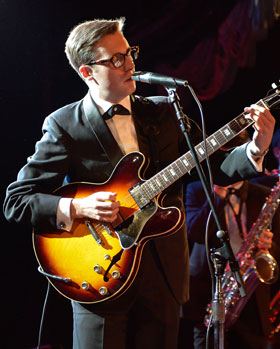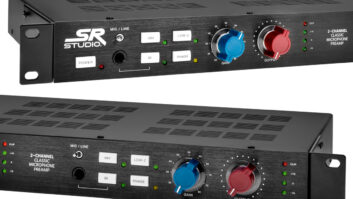
At Bimbo’s 365, Nick Watherhouse played his 2007 Gibson Custom shop ’63 Block Inlay 335, rewired by Dave Neely of Hollywood, Calif., with vintage wiring harness from RS Guitarworks and Throbak low-wind Humbucker pickups.
Photo: Steve Jennings
“The Gibson SG I play onstage was my first ‘real guitar,’” says Nick Waterhouse, he of the Golden Age sound and sensibility. “My dad picked it out and my parents gave it to me as an adolescent. I didn’t play it much through the years, as I bought a Rickenbacker 330 after my first summer job, thinking the SG was too much of a modern rock, heavy metal cliché, but a few years ago I started thinking of it not only as something personally significant, but also an oddball like myself. So I sort of took the wood and had it rebuilt electronically and hardware-wise—Kluson Waffleback tuners, bone nut, old-style smaller wire frets, fabric covered wire and paper in oil caps, a staple pickup from Seymour Duncan’s custom shop; it sort of turned into a black beauty ’55 Les Paul in the guts, but with a vintage Humbucker on the bridge. I cut most of the record with it. It just feels like ‘my guitar.’”
Waterhouse recorded his album, Times All Gone, at Mike McHugh’s Distillery in Costa Mesa, Calif. Mix caught Waterhouse and his band—Jack Payne (bass), Jeff Luger (drums), Kyle Stephens (keyboard), Tim Hill (piano), Jon Lammers (baritone sax), George Schafer (tenor sax), Erin Harris and Brit Manor (backing vocals)—at a packed house on New Year’s Eve at the famed Bimbo’s 365 nightclub in San Francisco.

From left: Pianist Tim Hill, background vocalists Erin Harris and Brit Manor, and Nick Waterhouse.
Photo: Steve Jennings
“The board at the Distillery is a 16-channel Flickinger console, which has been famously linked to Muscle Shoals,” Waterhouse says. “[The studio] has a very large hexagon-shaped live room. The entirety of the record was tracked in this room, almost entirely live. Drums, bass, organ, piano, guitar, saxes and female vocals were all recorded at the same time on every tune.
“To me, it was very much the directness of the technique versus trying to replicate a ‘period’ sound,” he continues. “I was simply trying to make a record that sounded good to my ears, and Michael [McHugh] really helped prop me up when I wasn’t getting what I wanted. He would recommend microphones, such as RCA, Electro-Voice and Sony, but he urged me to use my ears.
“I recorded a lot of the album using a 1965 Magnatone M-10 amp, but that does not travel well and is rather quiet. I also used an Ampeg Reverberocket from ‘63 that I had acquired halfway through the record. On the road I use a Silverface Fender Twin amp—pretty universal and I know what I’m getting out of it.”

FOH engineer Chris Preston
Photo: Steve Jennings
Front-of-house engineer Chris Preston, a Santa Cruz native and partner in Live Oak Audio, was behind the console for Waterhouse’s New Year’s Eve show. The two had met when Preston was mixing Black Mountain and The Allah-Las in Los Angeles at the 2012 FYF Fest.
“At Bimbo’s, I used a Midas XL200 console—awesome boards, give me one every day!” Preston exclaims. “They have a great selection of processing tools at FOH there at Bimbo’s, but still, the only unit I used was their Yamaha SPX 2000 for reverb and my [DeltaLab] Effectron for delay. I used two channels of dbx 166 to crush the vocals for some double-bused grit without overdriving the preamp. Mixing Nick and the band it’s pretty much a case of ‘good input equals good output.’ Everybody in the band knows their part and how to play it. They make my job easier.
“Nick’s vocal mic, the Ampex 3001 from 1966, was an eBay score last year that has proved its worth a hundredfold. It was new, never used, in the original box and actually smells like 1966. This mic works perfectly for Nick’s style; plus, it comes from about the right time period as the overall sound should feel. If I can find a few more I’d use them on the girls as well. Unfortunately, the only other 3001 I know about is part of the collection at MoMA in New York.”

Monitor engineer John Anaya
Photo: Steve Jennings
Bimbo’s monitor engineer John Anaya is mixing on an analog Soundcraft MH3 console. “There were no effects requested, so I’m utilizing some of our rack gear, the TC Electronic EQ station—smart and easy EQ on every send to the stage. We also have external compressors and gates and Lexicon effects for stage mixes. The stage wedges for the show were Radian MicroWedge. I used nine mixes to the stage for this act. We also have a Meyer powered sub for the low end of our drum mix.
“As for microphones, Chris [Preston] brought a vintage Ampex 3001 for Nick’s vocal,” Anaya continues. “Pretty standard fare otherwise. Specials were M88 on tenor sax and a 421 on baritone, 421 on bass cab with a Countryman DI; it was one of the cleanest and better-sounding bass rigs I have seen at Bimbos in some time—Mesa head and Ampeg small cab. For the drums we had EV 868 on kick, Beta 56 on snare, 57s, 604s and a pair of Shure small-diaphragm condensers, KSM 137s. For Nick’s Silverface [Fender Twin] amp we had 57s, and for the background vocalists we had 58s.”







